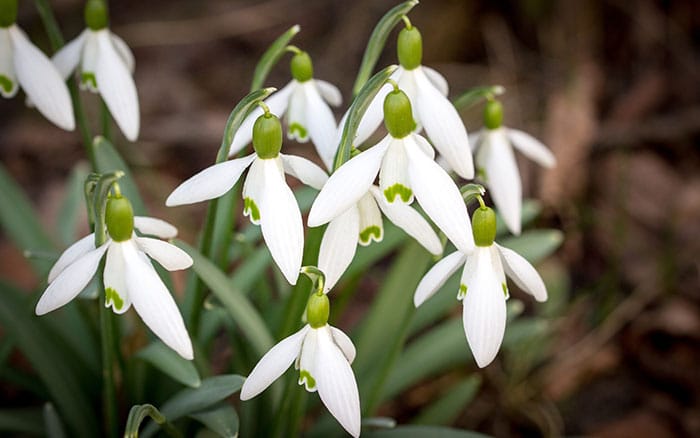Let’s get this year off to a great start by introducing flowers to our garden that symbolise hope and good fortune. I’m a firm believer in the positive power of plants and having these in your garden is sure to make it look brighter.
So, here are a few of my favourites:
1. Galanthus nivalis (snowdrop)
First is one of the earliest bulbs to bloom in the year, so they represent new starts, rebirth, and hope. Their nodding white flowers are fragrant too which makes them an even more beautiful addition to your garden. They are a perfect plant for pollinators too, making them a great addition to a wildlife garden.
• Sun – Partial shade
• Position – South, North, West, or East-facing
• Exposure – Exposed or sheltered
• Moisture – Moist but well-drained, or well-drained
• Soil – Chalk, clay, loam, or sand

2. Prunus (prunus)
Prunus covers a large genus of more than 400 species of flowering and fruiting trees. The simple leaves are joined by marvellous flowers that can be found in a variety of colours including pink and white.
Most of the family are deciduous trees, such as almond trees, plum trees, cherry trees, and peach trees. Also a symbol of the hope of spring, they are a beautiful plant to have in your garden.
• Sun – Full sun or partial shade
• Position – South, North, West, or East-facing
• Exposure – Exposed or sheltered
• Moisture – Moist but well-drained, or well-drained
• Soil – Chalk, clay, loam, or sand

3. Ornithogalum (star of Bethlehem)
With white flowers shaped like stars that contrast beautifully with the brilliant green stems, your containers, borders, or rock garden will look charming with this addition. The plant’s name derives from Greek; ornithos meaning bird and gala meaning milk, referring to the white flowers.
These delicate looking flowers are a popular pick for uses in flower bouquets and arrangements.
• Sun – Full sun or partial shade
• Position – South or West-facing
• Exposure – Exposed or sheltered
• Moisture – Well-drained
• Soil – Chalk, loam, or sand

4. Myosotis sylvatica (garden forget-me-not)
Next is another popular plant for pollinators, and you can enjoy the flowers too which are small, bright blue blooms that appear in spring and summer. As its name may suggest, this flower represents hope and remembrance.
• Sun – Partial shade
• Position – South, North, West, or East-facing
• Exposure – Exposed or sheltered
• Moisture – Moist but well-drained
• Soil – Chalk, clay, or loam

5. Papaver rhoeas (common poppy)
The bright red, saucer-shaped flowers that bloom in summer are a striking addition to a wildflower meadow, cottage garden or wildlife garden as they are popular with the pollinators.
As a symbol of hope, resilience, and remembrance this flower will be sure to bring something special. Throughout history poppies have played an important role in medicine, religion, mythology, and agriculture.
• Sun – Full sun
• Position – South, North, West, or East-facing
• Exposure – Exposed or sheltered
• Moisture – Well-drained
• Soil – Chalk, loam, or sand
6. Centaurea montana (perennial cornflower)
Next up is a perennial with intriguing purple flowers that bloom in spring and summer. A hardy pick for a coastal garden or prairie planting. Not only are they pretty but they symbolise hope, devotion, and love.
These flowers were found in Tutankhamun’s tomb in a garland and kept a lot of their colour even though they were over 3000 years old.
• Sun – Full sun or partial shade
• Position – South, North, West, or East-facing
• Exposure – Exposed or sheltered
• Moisture – Moist but well-drained
• Soil – Chalk, loam, clay, or sand

7. Iris
Irises are easy-to-grow and very rewarding because of their wonderfully shaped flowers that can be found in many cheery colours. In fact, the flower gets its name from the Greek word iris which means rainbow, sharing its name with the Greek goddess of the rainbow.
Growing conditions will depend on the type of iris.

8. Eranthis hyemalis (winter aconite)
Low growing to up to 10cm, the bright yellow blooms that flower in late winter will bring a burst of colour early in the year.
The name of the plants comes from the Greek words er which means spring and anthos which means flower referencing their early flowering. This is also the reason that they symbolise rebirth and new beginnings.
• Sun – Full sun or partial shade
• Position – South, North, West, or East-facing
• Exposure – Exposed or sheltered
• Moisture – Moist but well-drained or well-drained
• Soil – Chalk, loam, clay, or sand

9. Leucojum vernum (spring snowflake)
Next is another bulbous perennial that grows to 30cm tall with upright stems and glossy foliage, which is joined by bell-shaped white flowers. Plant the bulbs in autumn for spring flowers that symbolise purity and hope.
• Sun – Full sun
• Position – South, North, West, or East-facing
• Exposure – Exposed or sheltered
• Moisture – Moist but well-drained
• Soil – Chalk, loam, clay, or sand

10. Passiflora (passion flower)
Finally, the exotic looking flowers of Passiflora will add some beauty to a sunny but sheltered spot. A great climber for your garden, they also have other uses.
Passion flowers can also be used in food and beverage flavouring as well as having a history of medicinal benefits to help treat anxiety, insomnia, and wounds.
• Sun – Full sun and partial shade
• Position – South, or West-facing
• Exposure – Sheltered
• Moisture – Moist but well-drained
• Soil – Chalk, loam, or sand


Leave A Comment